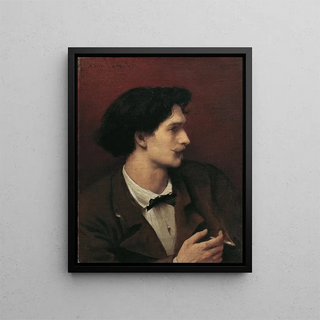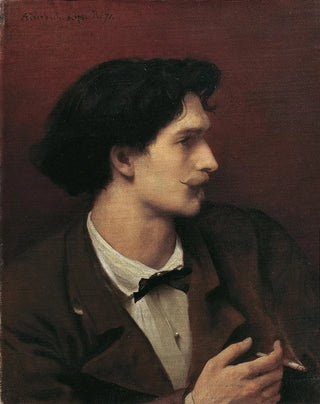Art print Self-portrait with cigarette - Anselm Feuerbach | Art print


View from behind

Frame (optional)
Autoportrait with cigarette by Anselm Feuerbach is a work that transcends the simple exercise of self-representation to become a profound reflection on identity and the human condition. Created in the 19th century, this iconic piece reveals not only the artist's face but also the struggles and aspirations of a rapidly changing era. In this painting, Feuerbach presents himself with a cigarette, a symbol of both introspection and modernity, inviting the viewer to delve into a universe where art and life are intimately intertwined. The soft light bathing the artist's face, along with carefully chosen color nuances, creates an atmosphere that is both intimate and universal, capturing the very essence of human existence.
Style and uniqueness of the work
The Autoportrait with cigarette stands out for its unique style, blending realism and romanticism. Feuerbach masters the art of light, using delicate shadows to shape his face with striking precision. The artist's features, both expressive and serene, testify to deep introspection, while the cigarette, casually held between his fingers, evokes a moment of reflection. This iconographic choice is not accidental; it embodies both a nonchalant attitude and an existential quest. The rich colors and carefully crafted textures enhance the psychological dimension of the work, creating a dialogue between the artist and his audience. Thus, each gaze upon this painting becomes an invitation to explore the intricacies of human thought and emotion.
The artist and his influence
Anselm Feuerbach, a major figure in 19th-century German painting, knew how to leave his mark through an innovative and personal approach to art. Trained at the Munich Academy, he was influenced by masters such as Delacroix and Ingres but developed a distinctive style that combines classicism with contemporary elements. Feuerbach is also recognized for his ability to capture the nuances of the human soul, a trait that is reflected in the Autoportrait with cigarette. His work has not only inspired his contemporaries but continues to influence

Matte finish

View from behind

Frame (optional)
Autoportrait with cigarette by Anselm Feuerbach is a work that transcends the simple exercise of self-representation to become a profound reflection on identity and the human condition. Created in the 19th century, this iconic piece reveals not only the artist's face but also the struggles and aspirations of a rapidly changing era. In this painting, Feuerbach presents himself with a cigarette, a symbol of both introspection and modernity, inviting the viewer to delve into a universe where art and life are intimately intertwined. The soft light bathing the artist's face, along with carefully chosen color nuances, creates an atmosphere that is both intimate and universal, capturing the very essence of human existence.
Style and uniqueness of the work
The Autoportrait with cigarette stands out for its unique style, blending realism and romanticism. Feuerbach masters the art of light, using delicate shadows to shape his face with striking precision. The artist's features, both expressive and serene, testify to deep introspection, while the cigarette, casually held between his fingers, evokes a moment of reflection. This iconographic choice is not accidental; it embodies both a nonchalant attitude and an existential quest. The rich colors and carefully crafted textures enhance the psychological dimension of the work, creating a dialogue between the artist and his audience. Thus, each gaze upon this painting becomes an invitation to explore the intricacies of human thought and emotion.
The artist and his influence
Anselm Feuerbach, a major figure in 19th-century German painting, knew how to leave his mark through an innovative and personal approach to art. Trained at the Munich Academy, he was influenced by masters such as Delacroix and Ingres but developed a distinctive style that combines classicism with contemporary elements. Feuerbach is also recognized for his ability to capture the nuances of the human soul, a trait that is reflected in the Autoportrait with cigarette. His work has not only inspired his contemporaries but continues to influence
12,34 €






